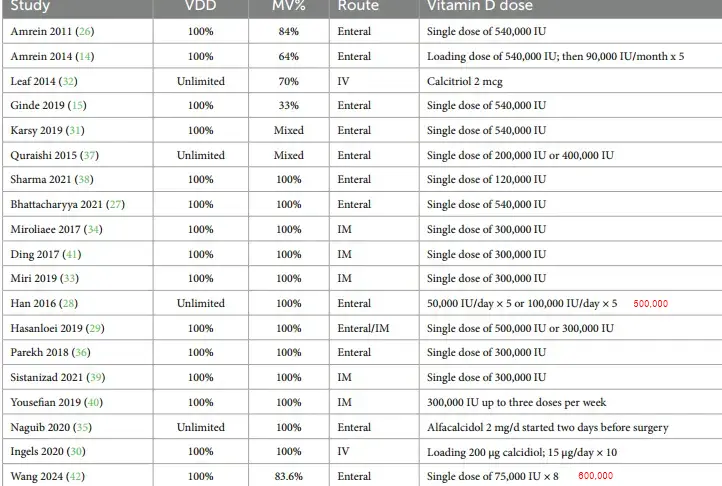ICU trials typically use 300,000 IU of Vitamin D - meta-analysis
Vitamin D supplementation in critically ill patients: a meta-analysis
Front. Nutr., 29 April 2025 https://doi.org/10.3389/fnut.2025.1505616
Wen-He Zheng&#x;Wen-He Zheng1†Jia-Heng Shi&#x;Jia-Heng Shi2†Da-Xing YuDa-Xing Yu2Hui-Bin Huang
Hui-Bin Huang2*
1Department of Critical Care Medicine, The Second People’s Hospital Affiliated to Fujian University of Traditional Chinese Medicine, Fuzhou, China
2Department of Critical Care Medicine, Guang'anmen Hospital, China Academy of Chinese Medical Sciences, Beijing, China

Background: Vitamin D is commonly used in clinical practice, while its clinical significance in critically ill patients remains controversial. Therefore, we aimed to perform a systemic review and meta-analysis to investigate the effect of vitamin D on this patient population.
Methods: We searched for randomized controlled trials (RCTs) in PubMed, Embase, and the Cochrane Library databases from inception until August 15, 2024. Studies evaluating critically ill adult patients who received vitamin D compared to controls were included. The primary outcome was short-term mortality. We used the Cochrane risk of bias tool and GRADE system to evaluate the study quality and evidence. Secondary outcomes were changes in serum 25-hydroxyvitamin D levels, mechanical ventilation (MV) duration, and length of stay (LOS) in the ICU or hospital. We also conducted meta-regression, subgroup analyses, and trial sequential analysis (TSA) to explore the potential heterogeneity among the included trials.
Results: Nineteen RCTs with 2,754 patients were eligible. Overall, vitamin D significantly increased serum 25-hydroxyvitamin D levels and significantly reduced the short-term mortality (risk ratio [RR] = 0.83; 95%CI, 0.70–0.98; p = 0.03, I2 = 13%), duration of MV (MD = −2.96 days; 95% CI, −5.39 to −0.52; I2 = 77%; p = 0.02) and ICU LOS (MD = −2.66 days; 95% CI, −4.04 to −1.29, I2 = 70%; p = 0.0001) but not hospital LOS (MD = −0.48 days; 95% CI, −2.37 to 1.40; I2 = 31%; p = 0.61). The meta-regression analysis revealed that the proportion of MV (MV%) accounted for the source of heterogeneity, and the subgroup analyses based on MV% suggested that the MV group was more likely to benefit from vitamin D applications than the partly MV group in all the predefined outcomes (all p values<0.05). TSA for short-term mortality suggested that more data is required to confirm our main conclusion.
Conclusion: Vitamin D supplementation increased serum 25-hydroxyvitamin D levels and significantly benefited critically ill patients, especially those with MV.
📄 Download the PDF from VitaminDWiki
VitaminDWiki - ICU patients typically benefit from 300-500,000 IU of Vitamin D - many studies
VitaminDWiki - ICU - need Vitamin D ASAP - interview and transcript, Matthews Aug 2024
VitaminDWiki - 4.8 X more likely to die within 28 days of ICU if low Vitamin D - Jan 2024
VitaminDWiki - ICU cost reduced by at least 27,000 dollars if get high dose vitamin D in first week - April 2017
VitaminDWiki - Large dose Vitamin D before surgery was found to help by 35 studies
300,000 IU of Vitamin D - many studies
